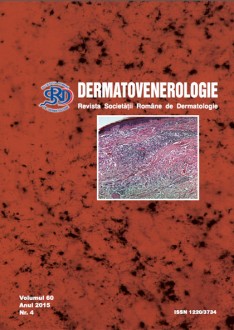Introducere. Granulomul inelar este o dermatoza cronica benigna, al carui aspect clinic si histologic (granulom palisadic) este caracteristic.
Caz clinic. Prezentam cazul unei paciente, in varsta de 52 ani, din mediul rural, care s-a spitalizat pentru placi ovalare si arciforme, cu diametrul intre 4-9 cm, cu margini formate din coalescenta de mici papule ferme, ritematoase, cu centrul placilor usor hipopigmentat, fara atrofie cutanata, dispuse la nivelul trunchiului (predominand in regiunea decolteului) si bratelor, cu istoric de 18 luni. Pe baza anamnezei, examenului clinic, examenului histopatologic si investigatiilor de laborator am stabilit diagnosticele: granulom inelar diseminat, dislipidemie si litiaza biliara asimptomatica. Pacienta a urmat tratament cu antibiotic, antihistaminice, dermatocorticoizi potenti si agenti fizici cu evolutie discret favorabila.
Discutii. Etiopatogenia nu este elucidata. In ceea ce priveste asocierea cu o alta patologie, studiile au aratat asocierea cu diabet zaharat, boli tiroidiene, boli maligne si dislipidemie. In cazul nostru, pacienta a fost diagnosticata cu dislipidemie.
Concluzii. Modificarile profilului lipidic (hipercolesterolemie, hipertrigliceridemie sau ambele) s-au dovedit a fi prezente la 45% din pacientii cu granulom inelar diseminat, de unde importanta investigarii pacientiilor in aceasta directie. Fara studii comparative, este dificil sa se stabileasca eficienta mijloacelor terapeutice, deoarece in 50-70% din cazurile de granulom inelar localizat s-au observat remisii spontane in primii doi ani de boala. Granulomul inelar diseminat este mai rezistent la tratamentul topic si sistemic, in comparatie cu forma localizata a bolii.


